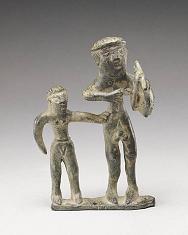Grades/Level: Lower Elementary (K–2), Upper Elementary (3–5)
Subjects: Visual Arts, English–Language Arts, History–Social Science
Time Required: 3–5–Part Lesson
Five 30-minute class periods
Author: J. Paul Getty Museum Education Staff
Permissions: 
The lesson plan and downloadable materials on this page are licensed under a Creative Commons Attribution 4.0 International License. |
 |
|
 |
Students will discuss what is communicated in an ancient statuette by analyzing the size and poses of two figures. They will learn that stories were passed through oral tradition in ancient times. They will create sculptures of themselves, a companion, and a favorite musical instrument using spheres and cylinders, and then recite a story inspired by their sculptures. |
 |
 |
 |
Download the complete lesson by clicking on the "Download this lesson" icon above.
Glossary Terms:
Words in bold on these pages and in the lesson are defined in the glossary for this curriculum (see "Performing Arts in Art Contents" links above). |
 |
 |
 |
| Statuette of a Lyre Player and His Companion, an unknown Greek artist, 690–670 B.C. |
 |
|
 |
Common Core Standards for English Language Arts
Grades K–5
SPEAKING AND LISTENING
K.1 Participate in collaborative conversations with diverse partners about kindergarten topics and text with peers and adults in small and larger groups.
K.4 Describe familiar people places, things, and events, with prompting and support, provide additional detail.
1.3 Ask and answer questions about what a speaker says in order to gather additional information or clarify something that is not understood.
1.4 Describe familiar people places, things, and events, with relative details expressing ideas and feelings more clearly.
2.4 Tell a story or recount an experience with appropriate facts and relevant, descriptive details, speaking audible in coherent sentences.
3.1 Engage effectively in a range of collaborative discussions (one-on-one, in groups, and teacher-led) with diverse partners on grade 3 topics and texts, building on others' ideas and expressing their own clearly.
3.4 Report on a topic or text, tell a story, or recount an experience with appropriate facts and relevant, descriptive details, speaking clearly at an understandable pace.
4.1 Engage effectively in a range of collaborative discussions (one-on-one, in groups, and teacher-led) with diverse partners on grade 4 topics and texts, building on others' ideas and expressing their own clearly.
5.1 Engage effectively in a range of collaborative discussions (one-on-one, in groups, and teacher-led) with diverse partners on grade 5 topics and texts, building on others' ideas and expressing their own clearly.
5.6 Adapt speech to a variety of contexts and tasks, using formal English when appropriate to task and situation. (See grade 5 Language standards 1 and 3 for specific expectations.)
|
 |

|
 |



